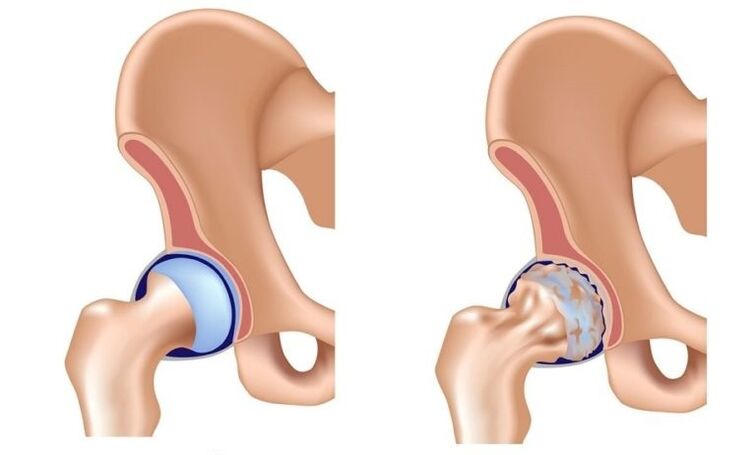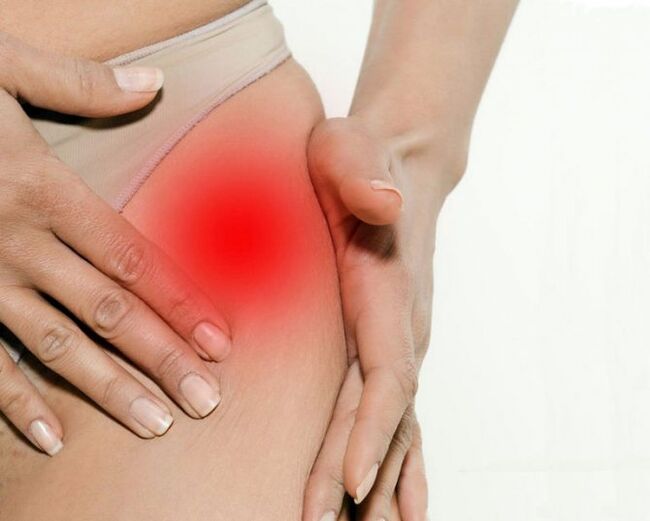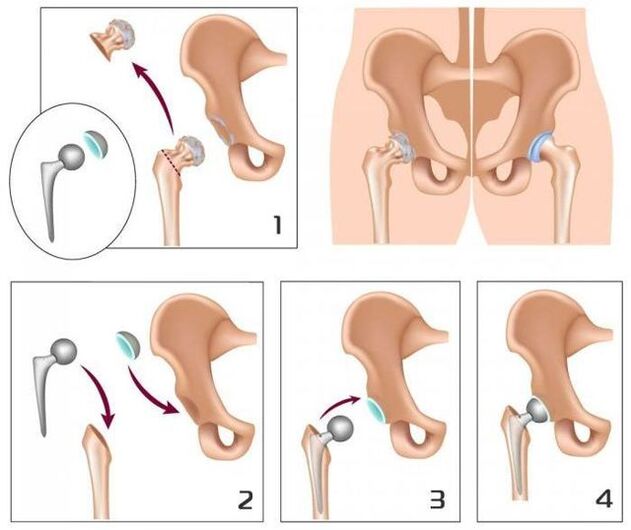
Osteoarthritis of the hip joint (deforming osteoarthritis, coxarthrosis, osteoarthrosis) is a slow progressive degenerative-dystrophic disease, which over time leads to destroying the affected joint, persistent pain and the limitation of mobility.
The disease affects people over the age of 40, women get sick several times than men.
In the overall structure of arthrosis, the arthrosis of the hip joint is part of the leading role.This is due to the widespread congenital pathology of the hip joints (dysplasia) and a significant physical exertion, for which these joints are susceptible.
Risk factors and causes of osteoarthritis of the hip joint
In the pathological mechanism of the development of the arthrosis of the hip joint, the main task is to change the physical-chemical properties of the synovial (intra-articular) liquid, whereby it becomes denser and viscoser.This worsens their lubrication properties.When moving, the articular cartilage surfaces are rubbed together, rough and covered with cracks.Small hyaline cartilage particles are abandoned and fall into the joint cavity, which leads to the development of an aseptic (non -infectious) inflammation in IT.While the disease goes into the inflammatory process, the bone tissue is drawn into the inflammatory process, which leads to aseptic necrosis of the cuts of the thigh head and the surface of the acetabulum, the formation of osteophytes (bone growth), the inflammation and movement.
In the late extent of the arthrosis of the hip joint, the inflammation is also thrown into the surrounding tissue (blood vessels, nerves, ligaments, muscles), which leads to the occurrence of signs of periarthritis.As a result, the hip joint is completely destroyed, its functions are lost, the movement in IT stops.This disease is referred to as ankyloses.
Causes of arthrosis of the hip joint:
- Congenital lip of the thighs;
- Hip dysplasia;
- Aseptic necrosis of the thigh head;
- Peters illness;
- Injuries to the hip joint;
- Infectious arthritis of the hip joint;
- Gonarthrosis (deforming osteoarthrosis of the knee joint);
- Osteochondrosis;
- Obesity;
- professional sport;
- flat feet;
- Craumatic of the spine;
- A sitting lifestyle.
Pathology is not inherited, but the child inherits the characteristics of the structure of the musculoskeletal system from his parents, which can cause arthrosis of the hip joint under these conditions.This explains the fact of the existence of families whose incidence is higher than in the general population.
Forms of the disease
Depending on the etiology, the osteoarthritis of the hip joint is primarily divided into a primary and secondary one.Secondary osteoarthritis develops against the background of other diseases of the hip joint or his injuries.The primary form is not related to the previous pathology, the reason for your development is often not possible, in this case you talk about idiopathic osteoarthritis.
Coksart rose is one or bilateral.
Level
Three levels (degrees) are differentiated during the arthrosis of the hip joint:
- Initial changes - Pathological changes are expressed slightly, provided that timely and adequate treatment is reversible.
- Progressive coxarthrosis - characterized by a gradual increase in symptoms (pain in the joint and affects its mobility), changes in the joint tissue are already irreversible, but therapy can slow down degenerative processes.
- The final movement in the joint is lost, ankyloses are formed.The treatment is only possible surgically (replace the joint with artificially).
Endoprosthetic operations in 95% of cases ensure a complete restoration of the mobility of limbs and restore the patient's performance.

Symptoms of arthrosis of the hip joint
The main signs of osteoarthritis of the hip joint:
- Pain in the bar, hips and knees;
- A feeling of stiffness in the affected joint and the restriction of his mobility;
- Lameness;
- Restriction of the kidnapping;
- Atrophic changes in the muscles of the thigh.
The presence of certain symptoms of arthrosis of the hip joint and its severity depends on the degree of illness.
On the 1st arthrosis of the hip joint, the patients complain about the pain in the affected joint, which occurs under the influence of physical activity (longer walking, running).In some cases, the pain is located in the area of the knee or thigh.After a short break, the pain runs by itself. The volume of the limb movements is completely preserved, the passage is not broken.The following changes are determined on the X -ray image:
- slight uneven decrease of the lumen of the common gap;
- Osteophytes on the inside of the swivel.
Changes from the neck and thigh head are not recognized.
With the II degree of osteoarthritis of the hip joint, pain also appears in peace, even at night.After physical activity, the patient begins to sleep, a characteristic "ducks" provider.This will occur in this way - after a long period of immobility, the first few steps cause pain and symptoms, which then return and return after a long load.In the affected connection, the movement volume (abduction, internal rotation) is limited.The X -ray image shows that the common gap is unevenly narrowed and its lumen is 50% of the standard.Osteophytes are located along the inside and on the outer edge of the joint cavity and go beyond the limits of the cartilage.The contours of the thigh head become uneven due to deformation.
With the III degree of arthrosis of the hip joint of the pain, intensive and constant, do not stop at night.Going is much difficult, the patient is forced to rely on the stick.The volume of the movements in the affected connection is very limited, later it stops completely.Due to the atrophy of the hip muscles, the pelvis deviates in the frontal level and the limb is shortened.The attempt to compensate for this shortening must be forced to reject the body towards the lesion, which further increases the load on the painful joint.In the case of X -rays, several bone growth, a significant narrowing of the common gap and a pronounced increase in the head of the femur are found.
Diagnosis
The diagnosis of the arthrosis of the hip joint is based on the data of the clinical image of the disease, the results of the medical examination and the instrumental studies, below which the main value belongs to visualization methods - radiography, calculated or magnetic resonance imaging.They not only allow the presence of osteoarthritis of the hip joint and evaluate its degree, but also the possible cause of the disease (trauma, youthful epiphysiolys, Peters disease).
The differential diagnosis of arthrosis of the hip joint with other diseases of the movement apparatus system is quite complicated.On the degree of osteoarthritis of the hip joint II and III, muscle atrophy develops that can cause intensive pain in the knee joint, which is characteristic of the drive or gonarthrosis (diseases of the knee joint).For the differential diagnosis of these conditions, the palpation of the knee and hip joints is gropped, the movement volume in them is determined and they are also examined radiologically.
In the event of diseases of the spine, the nerve roots of the spinal cord are pressed in some cases with the development of pain syndrome.Pain can shine into the area of the hip joint and imitate the clinical image of its defeat.However, the nature of the pain with the radicular syndrome differs easily from the arthrosis of the hip joint:
- Pain occurs as a result of weightlifting or sharp, unpleasant movement and not under the influence of physical exertion;
- The pain is located in the overall area in the buttocks area.
With the radicular syndrome, the patient can calmly take his leg to the side, while the kidnapping with arthrosis of the hip joint is limited.A characteristic sign of the radicular syndrome is a positive symptom of tension - the appearance of sharp pain when trying to increase a straight leg on the patient's back.
The arthrosis of the hip joint affects people over the age of 40, women get sick several times than men.
The arthrosis of the hip joint should also be differentiated with a loyal bursite (trochanteritis).Bursible Bursitis develops faster within a few weeks.Usually he is preceded by considerable physical exertion or injuries.With this disease, the pain is much more pronounced than in the arthrosis of the hip joint.At the same time, it is not determined that the limb and limitation of your mobility is determined.
The clinical image of atypical reactive arthritis and ankylosing spondylitis can resemble the clinical manifestations of the arthrosis of the hip joint.In patients, however, pain occurs mainly at night or in peace if walking does not increase, but on the contrary.In the morning, the patients notice the stiffness in the joints, which refers to after a few hours.
Treatment of the arthrosis of the hip joint
Orthopäder deals with the treatment of osteoarthritis of the hip joints.Conservative therapy is indicated with I and II disease level.In the case of a pronounced pain syndrome, the patient is not steroidal anti -inflammatory medication in a short course.They should not be accepted for a long time, since they not only have a negative impact on the organs of the stomach tract, but also suppress the regenerative capabilities of the hyalink cartilage.
In the treatment scheme of osteoarthritis of the hip joint, they include chondroprotectors and vasodilators, which creates optimal possibilities for restoring damaged cartilage tissue.With pronounced muscle spasm, central muscle relaxants may require the appointment of muscle relaxants.
In cases where it is not possible to stop pain syndrome with non -steroidal anti -inflammatory drugs, use intra -articular injections of corticosteroids.
The local treatment of the arthrosis of the hip joint using heat ointments enables you to reduce muscle spasms and weaken the pain due to distracting effects.
Physiotherapeutic methods are also used in the complex therapy of arthrosis of the hip joint:
- Magnetotherapy;
- Inductothermia;
- UHF;
- Laser therapy;
- Ultrasound treatment;
- Massage;
- Medical gymnastics;
- Manual therapy.

The nutrition of diet for the arthrosis of the hip joint aims to correct the body weight and the normalization of metabolic processes.Reducing body weight reduces the load on the hip joints and thereby slowing down the progression of the disease.
In order to unload the affected joint, the doctor can recommend that the patients go into the crutches or the stick.
With the III degree of arthrosis of the hip joint, conservative treatment is inefficient.In this case, it is possible to improve the patient's condition.It is possible to return normal mobility only as a result of a surgical intervention - the replacement of the destroyed joint with artificially (common endoprosthetics).
Possible consequences and complications
The most serious complication of progressive arthrosis of the hip joint is a disability due to the loss of movement in the joint.With bilateral coksart, the patient loses his ability to move independently and need constant external care.A long stay in bed in a position creates the prerequisites for the occurrence of stagnant (hypostatic) pneumonia, which is difficult to stand up and can lead to death.
The pathology is not inherited, but the child inherits the characteristics of the structure of the musculoskeletal system from its parents, which can lead to osteoarthritis of the hip joint.
forecast
The osteoarthritis of the hip joints is a progressive chronic disease that can only be completely healed in the early stages, provided the cause of the disease is eliminated.In other cases, the therapy enables you to slow down your course.Over time, however, there is an implantation of the hip endoprostheses.Such operations in 95% of cases offer a complete restoration of the mobility of the limbs and restore the patient's performance.The lifespan of modern prostheses is 15 to 20 years after which they are replaced.
prevention
The prevention of osteoarthritis of the hip joint aims to remove the causes that can lead to the development of this disease and includes:
- Corporate detection and treatment of diseases and injuries to the hip joint;
- Rejection of a seated lifestyle, regular, but not excessive physical activity;
- Body weight control;
- rational nutrition;
- Rejection of bad habits.



























